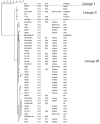Modification of rotavirus multiplex RT-PCR for the detection of G12 strains based on characterization of emerging G12 rotavirus strains from South India
- PMID: 17607780
- PMCID: PMC2465801
- DOI: 10.1002/jmv.20872
Modification of rotavirus multiplex RT-PCR for the detection of G12 strains based on characterization of emerging G12 rotavirus strains from South India
Abstract
Rotaviruses are the major etiological agents of diarrhea in children less than 5 years of age. The commonest G types in humans are G1-4 and G9. G12 is a rare human rotavirus (HRV) strain first reported in the Philippines. In this study, 13 G12 strains obtained from a community-based cohort and a hospital-based surveillance system in 2005 were characterized by phylogenetic analysis of partial nucleotide sequences of VP7, VP6, and NSP4 genes. Sequence and phylogenetic analysis of VP7 gene sequences showed that these southern Indian strains had the greatest homology with G12 strains recently reported from eastern India (97-99% identity both at the nucleotide level and deduced amino acid level) and less homology with the prototype G12 strain, L26 (89-90% identity at the nucleotide level and 90-94% at the deduced amino acid level). Phylogenetic analysis of the VP6 and the NSP4 genes revealed that the Vellore G12 strains belonged to VP6 subgroup II and NSP4 genotype B. The P types associated with these strains were P[6] and P[8]. A G12 type-specific primer was designed for inclusion in an established VP7 G-typing multiplex RT PCR, and tested against a panel of known G types and untyped samples and was found to detect G12 strains in the multiplex-PCR. Close homology of the South Indian G12 strains to those from Kolkata suggests that G12 HRV strains are emerging in India. Methods for characterization of rotaviruses in epidemiological studies need to be updated frequently, particularly in developing countries.
Figures





References
-
- Ball JM, Tian P, Zeng CQ, Morris AP, Estes MK. Age-dependent diarrhea induced by a rotaviral nonstructural glycoprotein. Science. 1996;272:101–104. - PubMed
-
- Banerjee I, Ramani S, Primrose B, Moses P, Iturriza-Gomara M, Gray JJ, Jaffar S, Monica B, Muliyil JP, Brown DW, Estes MK, Kang G. Comparative study of the epidemiology of rotavirus in children from a community-based birth cohort and a hospital in South India. J Clin Microbiol. 2006;44:2468–2474. - PMC - PubMed
-
- Castello AA, Arguelles MH, Rota RP, Olthoff A, Jiang B, Glass RI, Gentsch JR, Glikmann G. Molecular Epidemiology of Group A Rotavirus Diarrhea among Children in Buenos Aires, Argentina, from 1999 to 2003 and Emergence of the Infrequent Genotype G12. J Clin Microbiol. 2006;44:2046–2050. - PMC - PubMed
-
- Ciarlet M, Liprandi F, Conner ME, Estes MK. Species specificity and interspecies relatedness of NSP4 genetic groups by comparative NSP4 sequence analyses of animal rotaviruses. Arch Virol. 2000;145:371–383. - PubMed
Publication types
MeSH terms
Substances
Associated data
- Actions
- Actions
- Actions
- Actions
- Actions
- Actions
- Actions
- Actions
- Actions
- Actions
- Actions
- Actions
- Actions
- Actions
- Actions
- Actions
- Actions
- Actions
- Actions
- Actions
- Actions
- Actions
- Actions
- Actions
Grants and funding
LinkOut - more resources
Full Text Sources
Medical

